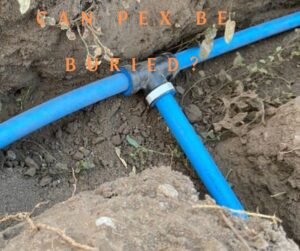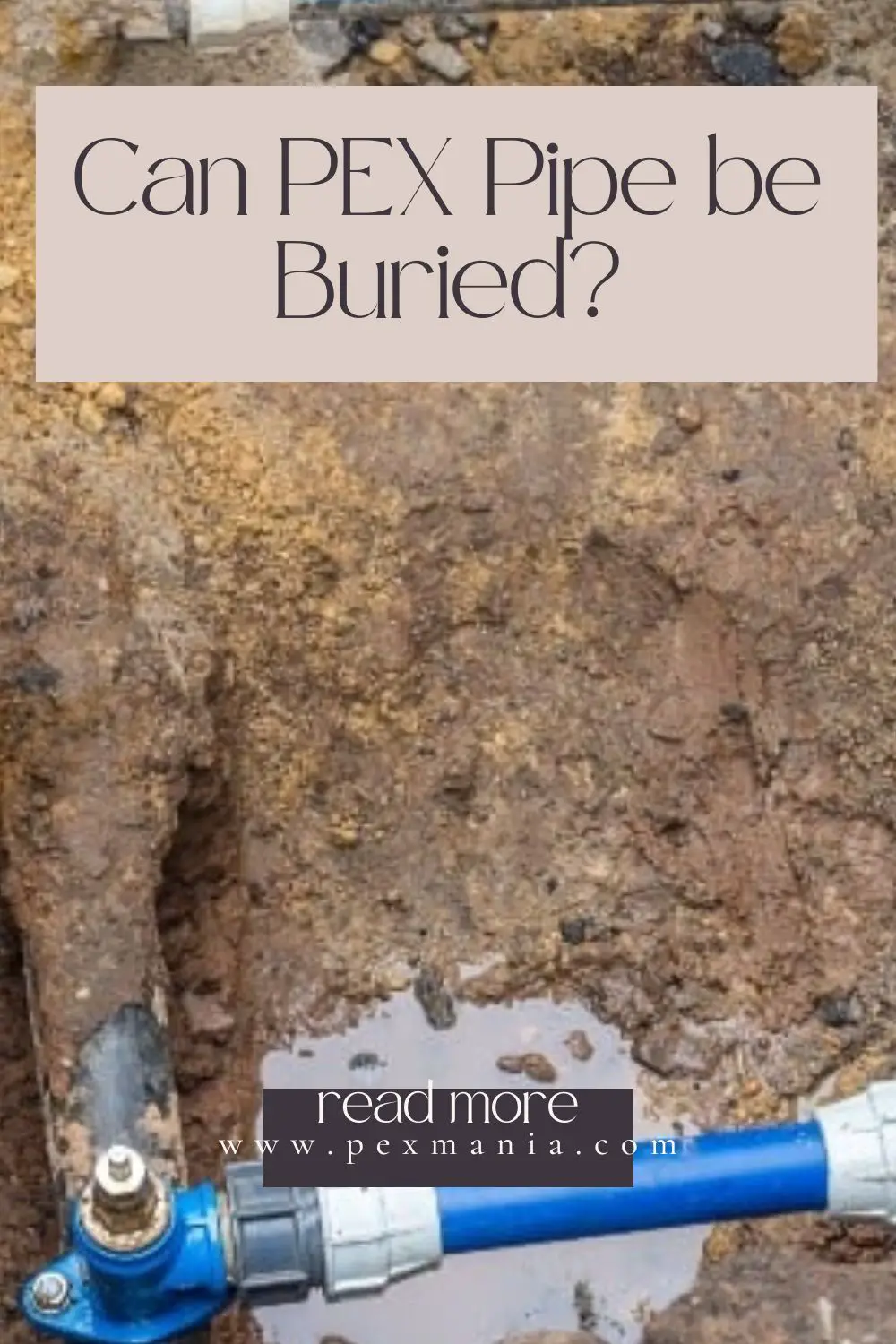Cross-linked polyethylene pipes popularly known as PEX is a light weight, non-corrosive and highly flexible polymer tubing used for residential water supply. Currently, PEX tubing is taking over the piping industry and all the traditional copper and galvanized steel pipes are being replaced with PEX. However, the question most people are asking is if you can bury PEX outdoors.
The Plumbing code in most states has approved the direct burial outdoors for PEX tubing. PEX is made of durable non-corrosive materials giving it a life expectancy of 40-50 years. When you bury PEX, you reduce the solar exposure that would essentially degrade the pipes.
Our local plumber assisted us in replacing the old copper pipe line running in the estate with a PEX mains and we love every bit of it. It is important to consult and read widely to know the exact type of PEX that works best underground.
A great expert tip when burying is to run PXE pipes through a PVC pipe before burying. The PVC acts like a shield or sleeve that insulates and protects the tubing from damages and severe freezing. It also make it very easy to repair PEX when its damaged. It is however key to check with your local plumbing code before such installations to ensure there are no limitations an or restrictions to such connections. You will also be allocated the area to dig by the local authority to ensure there is nothing buried when you intend to dig.
What Type of PEX Can Be Buried?
Generally speaking, you can bury any type of pex. However, some pex pipes will have a longer lifespan underground than others. The choice of PEX comes to play when it comes to transporting water in freezing conditions.
We recommend burying PEX-B outdoors as the first choice due to its high bursting pressure and low levels of leached chemicals
Many people shun using PEX pipes outdoors because it degrades when exposed to UV light. Essentially this means that the pipe will breakdown faster when exposed to the sun. the fact that the pipes don’t come very cheaply means that nobody is comfortable using it for a shorted period.
When you bury PEX pipes, you have a perfect and lasting solution to the sunlight exposure. The pipes will not degrade as long as you have limited their exposure to the sun prior and after installation.
Key Tip; Embed the PEX tubing in the sand once buried to reduce chances of soil and rocks damages.
PEX – A
PEX-A is the second choice pipe to bury outside after PEX-B. The fact that PEX-A is made using peroxide makes it the softest and most flexible and it also has the highest degree of cross-linking for the strongest chemical bond.
You get the benefit of having a non-corrosive pipe when using PEX-A when compared to other piping materials such as steel or copper. There are also very low chances of PEX-A tubing leaking or contaminating the water supply.
PEX –A is very easy to work with and it withstands moderate freezing conditions when buried. The fact that the pipe is more expensive than PEX –B gives you a better alternative in PEX-B when planning to bury your piping.
PEX –B
If you have finally made the decision to bury PEX tubing, then buy the PEX-B piping as the first priority. Not only will you get a perfect pipe to work with at a very friendly price but you will also get all the benefits of PEX –A and very few drawbacks.
The PEX-B tubes come with a higher bursting pressure which is highly recommended when burying pipes in areas that experience freezing temperatures. The pipes are also made from non-corrosive materials which greatly reduces any chances of chemical leaching making PEX –B a perfect choice for burying.
The main drawback of PEX-B is that it is a bit rigid and hard to work with. This is due to its manufacturing process that uses a moisture cure method which makes it less flexible.
In cases of kinking, you will have to dig up the pipe and cut off the kinked PEX –B part and replace it with another tubing and fixtures. For PEX -A you might need to use heat to remove the kinks though this is not recommended.(Source)
The main reason why we recommend PEX –B for burying is that it has an increased bursting pressure and it more cost effective when compare to PEX-A.
Buy PEX -B On Amazon.
PEX –C
The PEX –C tubes are the most rigid tubes in the PEX family. The manufacturing process that uses irradiation techniques makes it incredibly stiff. The pipe is highly prone to kinking and bursting when exposed to extreme conditions like freezing.
PEX-C requires regular repairs due to bursting and other damages hence they are not recommended for burial.
When compared to the other options, the only winning point of PEX –C is that it is the cheapest option when buying. However, this is watered down by the cost of maintaining and repairing the pipes over time.
PEX –C is a perfect fit for small repairs which need a short and sturdy pipe BUT not for lengthy underground piping works.
Best PEX Fittings For Underground Connections.
While as using PEX for underground connections is a big win, it would be meaningless if the wrong fittings will be used as they will not withstand the extreme conditions and cause numerous leaks with time.
When installing PEX you have the option of using crimp rings or clamps. However, when it comes to underground connections you will need to get a perfect fit that will work over the years.
The fact that PEX crimps are made of copper makes them a last option when fixing underground connections. This is because the crimps expand when exposed to freezing water and remain the same even when the temperatures rise causing a leak.
If you are inclined to metal connectors, you can use the stainless steel clamp ring as it is highly resistant to corrosion making it more suitable for burial.
If you are able to plan the process and have zero joints underground, then that would be a perfect piping system as it will have minimal issues in future. However, you can always have fittings in areas where it is inevitable like T – Joints.
Remember that anytime you join the pipe with a fitting, you are introducing a potential point of failure. Try and achieve a minimum in all your buried pipes and minimize the chances of issues in future.
Can Sharkbite Fitting be Used Underground?
The International Association of Plumbing and Mechanical Officials have Okayed the sharkbite fittings for burial. (Source)
Sharkbite is a renowned company that makes its fittings using lead-free brass push to connect fitting with a stainless steel 316 grab ring and an EPDM O-ring. The materials make the fitting very durable and dependable and it won’t contaminate the water supply. The fittings are compatible with multiple series of pipes making it a great option if you are combining PEX and other pipes.
To crown the sharbite fitting, it comes wrapped with a silicone tape making it very conducive for burial. The fittings are protected with this tape to ensure you get maximum benefits when you bury them underground. The silicone material protects the fittings from soil contaminants and any other chemicals and helps in ensuring the companies 25 – Years warranty.
The top quality materials used to make the lead-free brass fitting topped up with the silicone tape makes these fittings the perfect choice for any underground PEX tubing works.
Can you Bury PEX in Concrete?
PEX is classified as a HDPE(high density polyethylene) material which means that it is strong enough to handle going inside concrete. It is for this reason that it has been used largely for floor heating.
PEX has a high tolerance and its highly flexible making it a perfect choice for embedding in concrete floors.
Direct Burial of PEX Tubing
Did you know that PEX is approved for direct burial outdoors? If not, now you know and you can go ahead and bury it when running your water supply line to the house. The beauty with PEX is that it is flexible and it resists freezing more efficiently when compared to other rigid pipes. However, take note that PEX can still bust if water freezes in the line hence it is important to bury the PEX pipe below the frost line.
To get the depth of the frost line in your area, you need to contact the local water company or the municipality plumber. Ensure you get a continuous PEX line at all times when burying the pipes underground. However, you can use dezincification-resistant brass fittings or plastic PEX fitting in highly aggressive soil or water areas to reduce the chances of corrosion. We prefer using stainless steel clamp rings in the place of copper crimp rings when burying PEX pipes underground.

Final Word
There are many benefits that you get when you to use PEX for underground piping, they include;
- PEX is flexible,
- Its Temperature resistant
- Less expensive when compared to copper, PVC or CPVC.
- It comes in a roll hence require very few fitting if any. Always use appropriate fittings to withstand aggressive soils or water and other chemicals.
Go ahead and get that project running and enjoy peace of mind for the next 50 Years and beyond.
